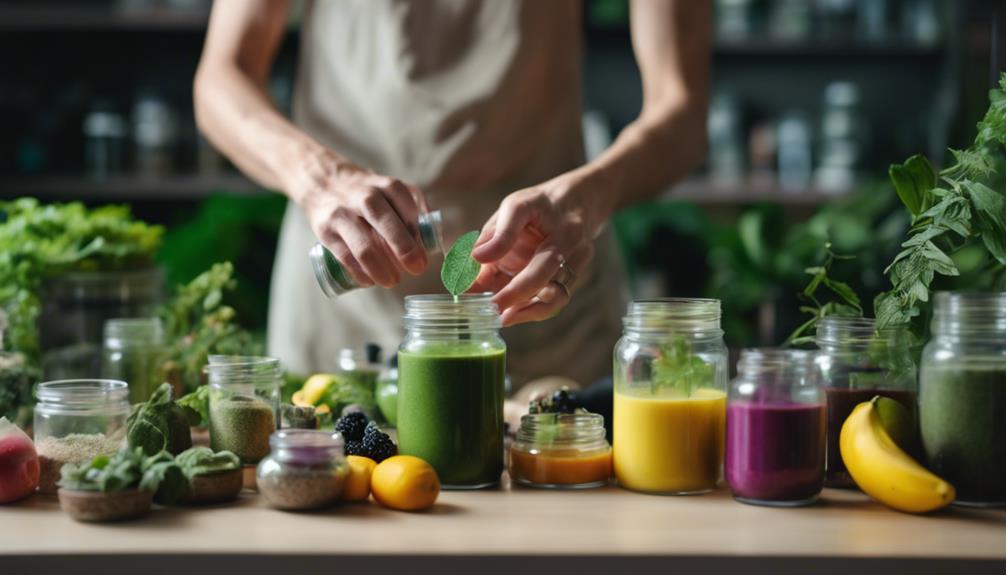To guarantee one's cannabis tolerance remains intact, employing effective strategies is essential for a sustainable relationship with the plant. Rotating cannabis strains helps prevent tolerance buildup and maintains sensitivity to cannabinoids, offering a diverse range of effects. Implementing the microdosing technique involves consuming controlled doses for ideal effects without building up a tolerance. Utilizing enhancing herbs and supplements like lavender and CBD supplements boosts relaxation and therapeutic benefits. Setting a tolerance management schedule with specific goals and maximizing potency with small doses are key strategies. Each method offers a unique way to maintain cannabis tolerance effectively, promoting a harmonious interaction with the plant.
Key Takeaways
- Rotate cannabis strains to prevent tolerance buildup.
- Implement microdosing for controlled effects.
- Use enhancing herbs/supplements for added benefits.
- Follow a tolerance management schedule for consistency.
- Maximize potency with small, effective doses.
Rotating Cannabis Strains
Regularly rotating cannabis strains is a recommended practice to prevent tolerance buildup and maintain sensitivity to cannabinoids. By switching between different types of cannabis, individuals expose their bodies to varying cannabinoid profiles, including levels of THC, CBD, and terpenes. This rotation offers a diverse range of effects as each strain interacts uniquely with the endocannabinoid system. The goal is to avoid developing a high tolerance to specific cannabinoids, ensuring that the desired effects of cannabis consumption remain potent over time.
Furthermore, rotating strains may enhance what's known as the entourage effect. This phenomenon occurs when various compounds in cannabis, such as cannabinoids and terpenes, work together synergistically to produce a more pronounced effect than any single compound alone.
Experimenting with different strains not only helps prevent tolerance but also keeps the overall cannabis experience enjoyable and effective for individuals seeking diverse therapeutic benefits.
Implementing Microdosing Technique

Implementing the microdosing technique involves consuming small, controlled doses of cannabis to achieve ideal effects. By starting with a low dose and gradually increasing it, individuals can find their perfect level without overwhelming their endocannabinoid system. This approach helps prevent building up a tolerance, as larger doses can lead to diminished effects over time.
Microdosing is a personalized method of cannabis consumption that aims to enhance focus, creativity, and mood without the intense high associated with larger quantities. It allows users to tailor their experience to meet specific therapeutic needs, providing a more targeted and sustainable way of using cannabis.
Through careful monitoring and adjustment of doses, individuals can harness the benefits of cannabis without the risk of tolerance development, making microdosing a valuable tool for those seeking subtle yet effective effects from this plant.
Utilizing Enhancing Herbs and Supplements

Incorporating enhancing herbs and supplements can optimize the effectiveness of a tolerance break. Certain herbs like lavender, chamomile, and valerian root can enhance relaxation and improve sleep quality during this period.
Supplements such as melatonin, magnesium, and L-theanine may help regulate sleep patterns and reduce anxiety or stress. Adaptogenic herbs like ashwagandha and rhodiola can support the body's stress response and promote overall well-being.
Moreover, CBD supplements or products can provide therapeutic benefits without the psychoactive effects of THC, aiding in relaxation and mood stabilization.
- Lavender, chamomile, and valerian root enhance relaxation and sleep quality.
- Melatonin, magnesium, and L-theanine regulate sleep patterns and reduce anxiety.
- Ashwagandha and rhodiola support the body's stress response and overall well-being.
- CBD supplements offer therapeutic benefits without the psychoactive effects of THC.
Setting Tolerance Management Schedule

Plan your tolerance management schedule by creating a detailed timeline that outlines when to start and end your tolerance breaks.
It's essential to set specific goals for your tolerance management, such as reducing THC intake or improving cannabis sensitivity.
Regular check-ins should be incorporated to assess progress and make any necessary adjustments to your schedule.
When planning your tolerance management schedule, consider factors like work commitments, social events, and personal activities to guarantee a realistic and achievable plan.
Utilize reminders or alarms to stay on track with your planned tolerance breaks and adjustments.
By adhering to a structured schedule and setting clear objectives, individuals can effectively manage their tolerance levels and optimize their cannabis experiences.
Maximizing Potency With Small Doses

Maximizing potency with small doses involves starting with the smallest effective dose of cannabis during a tolerance break. This strategy allows individuals to reset their tolerance levels while still benefiting from the therapeutic effects of cannabis.
To make the most out of small doses and enhance potency during a tolerance break, individuals can follow these tips:
- Experiment with different consumption methods like microdosing to achieve desired effects with minimal THC intake.
- Focus on high-quality, potent strains or products to maximize the effects of small doses during a tolerance break.
- Consider using a vaporizer or other efficient delivery methods to ensure optimal THC absorption with small doses.
- Keep a journal to track the effects of small doses accurately, aiding in the adjustment and fine-tuning of consumption for maximum potency during a tolerance break.
Frequently Asked Questions
How to Survive a T Break?
To survive a t break, one must implement strategies to manage cravings and withdrawal symptoms effectively.
Engaging in activities like exercise and hobbies can help distract from cravings. Keeping a journal to track progress and using CBD products for symptom management are beneficial.
Mindfulness techniques and seeking support from friends and family can reduce stress and provide motivation.
These approaches collectively contribute to a successful t break experience.
Will a 2 Day Tolerance Break Do Anything?
A 2-day tolerance break may offer a brief respite from cannabis consumption, with effects varying based on individual factors such as tolerance levels, frequency of use, and THC potency.
While minor adjustments in tolerance might be noticed, longer breaks are more effective for substantial tolerance reduction.
As a result, a 2-day break serves as a temporary pause rather than a complete reset of tolerance levels.
How Long Does It Take for Cannabinoid Receptors to Return to Normal?
Cannabinoid receptors typically take 2-4 weeks to return to standard levels after ceasing cannabis use. Various factors such as metabolism, genetic makeup, and frequency of use can influence this timeframe.
The process of receptor normalization is gradual and depends on the individual's cannabis consumption history. Peak receptor function post-tolerance break necessitates allowing the body sufficient time to readjust.
Conclusion
To sum up, maneuvering the world of cannabis consumption can be compared to sailing a ship through stormy seas. By carefully rotating strains, implementing microdosing techniques, utilizing enhancing herbs and supplements, and managing tolerance effectively, one can steer clear of rocky waters and guarantee a smooth journey towards maximizing potency and maintaining a stable course.
Remember, with the right strategies in place, the high seas of cannabis consumption need not be treacherous, but rather a voyage of exploration and discovery.









